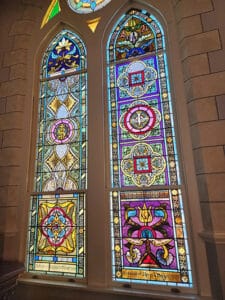The painted churches of Schulenburg, TX, are a testament to an otherworldly faith that seems alien today. Stepping into them felt like we were simultaneously time traveling and swapping into another dimension entirely. If you’re bringing your Tesla, there are enough charging options around to be free to explore.
Sts. Cyril and Methodius Catholic Church – Dubina, TX
Czech immigrants chose to settle near a large grove of oaks in 1856. They called their settlement Dubina as dub in Czech means oak grove. In 1877, they constructed their first church here. Tom Lee, a freed slave and blacksmith, made the iron cross that tops the steeple.

In 1909, many churches in the area including the Dubina settlement’s original church was destroyed by a hurricane. The community, determined to rebuild, raised the funds to hire architech Leo Dielmann to draw the plans for a new church. The iron cross that topped the original church was recovered from the rubble and also topped the steeple of the newly built church.


There are no surviving records of who did the church’s original artwork. Unfortunately, it was all painted over with white paint in the 1950s. Later on in the 1980s, the historical significance of the other painted churches was beginning to be recognized, and the parishioners restored the church with stencils found in the church. Other artwork was restored by carefully uncovering the old designs and replicating them. Not all of the parishioners were artists, but the parish decided to leave the results to divine inspiration and providence. I think it worked out quite well and is a testament to the faith and devotion of this parish.


Nativity of Mary, Blessed Virgin Catholic Church – High Hill, TX
Located in High Hill, Texas, St. Mary’s Catholic Church is known as the Queen of the Painted Churches. The Catholic State league was formed here and many of the church clergy we raised in High Hill. The first St. Mary’s church was built in 1869, but a larger one was built in 1876. The latter is a vibrant place of worship today. It features 18 stained glass windows as opposed to the plain glass windows favored in some of the churches built by Czech immigrants in the area.

When the newest St. Mary’s was built in 1906 by famed Texas architect Leo M. J. Dielmann, the 18 stained glass windows originally donated by the people of the parish were moved to this newer church. What is interesting about the design of this church is that local leaders went against the preference of the church hierarchy in Texas to build wooden churches in the functional mission style. The local leaders decided to build exteriors of stone and brick as they had lost many churches to storms and fires. The interior of St. Mary’s is wood but is protected by the exterior brick.




In 1912, Hermann Kern and Ferdinand Stockert did the decorative painting. The images were first painted on canvas and then glued to the wooden walls. The fascinating thing about the ceiling is that the vaults, or arches, are an illusion created by paint and are not structural.

St. John the Baptist Catholic Church – Ammannsville
This is the third church built in this location. The first was destroyed by the hurricane in 1909. The second was built by Leo Dielmann and burned in 1917. This second church’s exterior was Victorian in style and the interior was as intricate and ornate as St. Mary’s in High Hill. The current church, which was built in 1919, is so much simpler and has an open and airy structure.

The interior of the church is a unique, pinkish-brown color. The artist is unknown and disappeared once the work was completed. In the 1990s the design professor Buie Harwood compared known paintings to the ones at St. John’s and concluded that Fred Donecker was likely the painter at St. John’s.

Thinking of Visiting?
The Schulenburg Chamber of Commerce is a great resource for visiting the Painted Churches in the area. They sell a map and historical brochure for $5 or you can book a guided tour with a docent but it must be set up in advance. If you’re a Thousand Trails member, Colorado River Thousand Trails is nearby in Columbus, TX. I have a review of the campground available at the abo
In addition, the Texas Heroes Museum is not only a fascinating and well-organized museum dedicated to anyone who have made sacrifices for the betterment of Texas. The gentleman who runs it has an almost encyclopedic knowledge of Texas history and is also a fantastic source of recommendations of things to see in the area that are not well advertised.
I hope this has inspired you to explore the area around Schulenberg, TX, and find the beauty and history hidden in small-town Texas. Until next time, safe travels!